The 10 Greatest Non-Fiction Star Wars Books
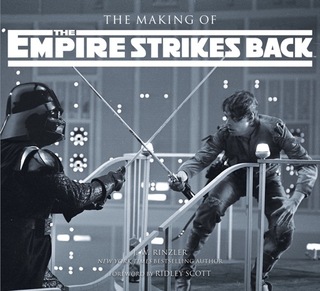 |
?The first hint of what a success Star Wars might be came in 1976 with the release of the film’s novelization (famously ghostwritten by Alan Dean Foster). That unassuming tome was the first brick laid in the foundation of what would become a publishing… well, empire. In the subsequent years, spin-off books have taught us that Princess Leia loves hot chocolate and Chewbacca should avoid moons whenever possible. Topless Robot has previously featured Daily Lists focusing on the best and worst that the Expanded Universe has to offer, but what of the various books that detail the production of the films, the merchandise, and the impact that Lucas’ work has had on fans throughout the years? Enter this look at the 10 best non-fiction Star Wars books. From personal memoirs to insanely researched production resources, this list is your guide to the greatest insights on a galaxy far, far away ever to be immortalized on the printed page.
10) The Star Wars Album
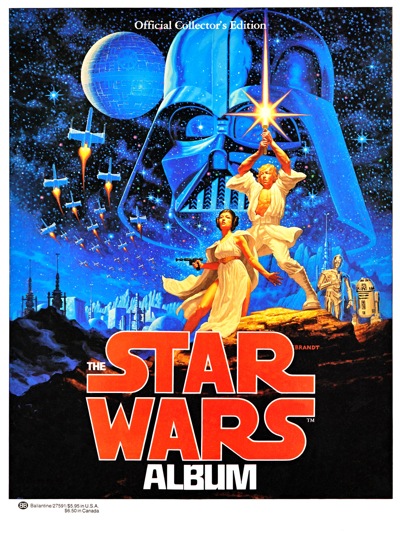 |
?It’s been well documented how the unexpected blockbuster success meant that there wasn’t too much merchandise from the film initially available. A notable exception is this slim volume made ion 1978 that features a Cliff Notes-esque overview of the movie’s characters and plot and a brief look at how it was made. Highlights include a terrific front and back cover by Greg and Tim Hildebrandt and a glossary that describes Grand Moff Tarkin as “the evil being who conceived and built the Death Star.” Elsewhere there’s the revelation of the disturbing fact that C-3P0 possesses something called a “pelvic servomotor” and the promise that a sequel would hit theaters in the fall of 1978 (a claim that is downright adorable in its inaccuracy). It’s not the most in-depth book, but for kitsch value alone it deserves a place in your library.
9) Collect All 21! Memoirs of a Star Wars Geek
 |
?In this self-published work, writer John Booth (one of Wired‘s Geek Dad bloggers) discusses his lifelong obsession with Star Wars and the toys and memories that came with it. Given that the target audience for the book is obsessives who still have dreams about owning a Blue Snaggletooth, the finished product could have wound up being the literary equivalent of shooting fish in a barrel. Instead, Booth presents a sometimes painful coming-of-age portrait in which Star Wars plays as important of a role in his life as the songs that “feel infinite” do to the protagonist of The Perks of Being a Wallflower. His candid reflections on the joy he felt whenever he played with his Star Wars “guys” and how his ebbing and flowing love for Luke and company helped him weather some personal crises and one especially volatile relationship are incredibly moving (as is a chapter in which he recounts the first time he ever saw Return of the Jedi that is so packed with childhood wonder it will make you want to hug an Ewok). And I defy you to not get weepy when he chronicles how he passed his torch of fandom to his daughter with his anecdotes about taking her to see Revenge of the Sith. Even though the details featured in Collect All 21! are specific to Booth’s personal experiences, the feeling of childhood magic that pours from its pages will have you reflecting on how much of an impact the Wars have had on you. Celebrate the love, yub yub.
8) The Empire Strikes Back Sketchbook
 |
?Ralph McQuarrie’s work on the original trilogy is a peerless bit of visualization that laid the groundwork for exactly how a galaxy far, far away would look (and let’s not forget how its use during Lucas’ pitch sessions was instrumental in getting the first film made to begin with). Equally worth mentioning is the storyboard/conceptualization design work of Joe Johnston and Nilo Rodis-Janero. Thus, this 1980 book that presents a collection of illustrations of key ships and characters from The Empire Strikes Back featuring work from the pair. What’s especially great about their art is how it furthers the vision of McQuarrie by enhancing his original concepts while creating new designs that are a natural extension of what their mentor was already doing. Then again, maybe I just have a thing for drawings of Probe droids. Moving on…
7) The Star Wars Question and Answer Book about Space
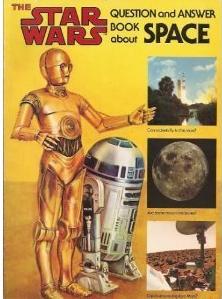 |
?There’s a scene in Where the Wild Things Are where Max quietly freaks out after his teacher nonchalantly mentions how the sun is going to eventually burn out and destroy life on Earth someday. This is a favorite factoid that science instructors everywhere to use to bum out kids whose ensuing realization of their own mortality offers up a pretty severe post-recess buzz kill (for the average child, death wasn’t really thought about until this gloomy bit of science trivia was thrown into their faces). The author of this 1979 book, Dinah L Moch?, goes even lower by having C-3P0 break this news to young readers. But she doesn’t stop there. Moch? further torments young readers by discussing the perils of asteroid strikes on Earth and how “powerful laser beams can be death rays if their energy is focused on a person.” Jesus. By the end of the book things get downright sadistic. In a dick move that almost certainly gave kids nightmares for weeks, a two-page segment discussing how black holes destroy anything in their path appears. The corresponding illustrations? Each of the droids standing right next to one, mere seconds away from being sucked into nothingness. Fact: If you hold this book up to your ear, you can hear the sounds of 1970s parents trying to convince their kids that Threepio didn’t really die in a black hole. Remember kids, science is fun… when it’s not scaring the hell out of you.
6) The Secret History of Star Wars
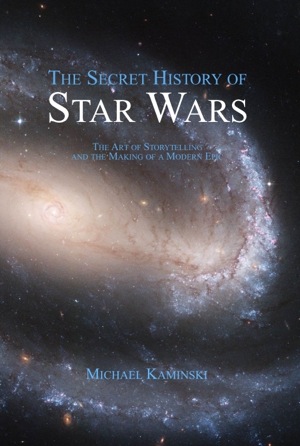 |
?Drawing from a ridiculous amount of sources (including TV interviews, newspaper articles and such great books as Star Wars: The Annotated Screenplays, Empire Building and Skywalking), writer Michael Kaminski has crafted the definitive word on the complete history of Star Wars. It’s common knowledge that Lucas has revised his own history almost as much as he has screwed with the original trilogy. But never before has a book crafted in such detail the various permutations of what George said and when. However, Kaminski isn’t doing so to call Lucas on the carpet for his hypocrisy and refusal to admit that he has changed his story over the years. Instead, he places Lucas’ changing statements into a greater context that charts the evolution (or, if you prefer, devolution) of the Star Wars saga across the course of both trilogies. At nearly 600 pages including lengthy appendices, an index and footnotes, the book comes across as the nerdiest thesis paper ever written. And a no-frills one at that. There’s no illustrations or photos inside and the whole affair is defiantly unauthorized. Nevertheless, Kaminski’s work is a perfect aggregator of all aspects of Lucasfilm history, from discarded script ideas to juicy behind the scenes nuggets. Because it is a labor of love that was printed through a small press, this will set you back nearly $40. Still, with this much information at your fingertips you’ll feel like your getting your money’s worth and then some.
—-
5) The Star Wars Vault
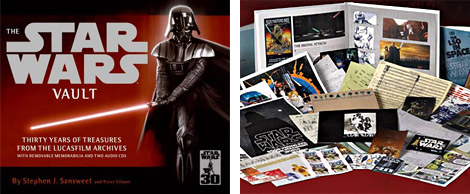 |
?Picking up where 1998’s The Star Wars Scrapbook left off, this 2007 collection of “30 years of treasures from the Lucasfilm Archives” is a nifty time killer that features information and Infocom-style feelies. Written by Steven Sansweet (more on him in a bit) and Peter Vilmur, it showcases a lightweight overview of the Star Wars phenomenon. But the real appeal here is the swag that is cleverly included in the pages thanks to some clever papercraft engineering. Amongst the highlights are a poster-sized replica of a Japanese camcorder ad that features an illustration of Lucas sitting on a sea creature that is attacking various Return of the Jedi characters, a reproduction of a Burger Chef Landspeeder FunMeal toy, a vintage iron-on and two CDs that feature audio treasures like radio ads and Carrie Fisher’s Lifeday song from The Star Wars Holiday Special (on second thought, some things are best left in the vault). It’s out of print now, but since it was released in 2007, copies shouldn’t be that hard to track down.
4) Star Wars: 1,000 Collectibles: Memorabilia and Stories from a Galaxy Far, Far Away
 |
?When I was getting ready to move last year, part of the logistics I had to deal with in finding a new apartment was landing one with the storage space for some of the sci-fi crap I’ve accumulated over the years. My collection is modest to be sure and is still a hassle to move, so I can’t imagine the headaches Steve Sansweet must endure whenever he switches residences. As you probably know, Sansweet is a journalist who parlayed his love for sci-fi collectibles into a full-time gig at Lucasfilm. He owns the world’s largest collection of Star Wars stuff, which is kept at his California property, the obnoxiously named Rancho Obi-Wan. In this book, Sansweet shows off the most noteworthy and unusual items in his collection. But before readers have a chance to get jealous of all the cool stuff Sansweet owns they are grounded by his personal recollections of each item and the friendships that Star Wars helped him build. Maybe this book will inspire you to take stock of your own collection, or at the very least make a cool Salacious Crumb out of packing tape.
3) Star Wars: Year by Year: A Visual Chronicle
 |
?In 1999, DK Publishing released a slew of Episode I books that failed to connect with readers. As a result of the poor sales, the company almost went out of business. Fortunately for us, the existence of Star Wars: Year by Year proves that DK haven’t held a grudge against Lucas and his work. Following a brief introduction that examines George Lucas’ primary influences, this quasi encyclopedia spans from 1973 to 2010 to place every Star Wars milestone within a historical context. What follows is a look at how the world shaped Lucas’ vision…and how he went on to return the favor. Although the book primarily focuses on major Star Wars events within each year, it also looks at notable societal, political and pop culture events of the era. Thusly, the formation of Pixar in April of 1986 shares page space with an article about the final issue of Marvel’s Star Wars comic. The nugget-sized bits of trivia — many of which present information that hasn’t been heavily reproduced elsewhere — are endlessly fascinating to read, if a bit haphazardly organized given the book’s basic design (in a questionable move, the entry on the 9/11 attacks coincides on the page with the announcement of Scholastic’s Jedi Quest book line, and gets the same amount of coverage). Any slight gripes with the layout are easily overshadowed by the fun that comes from flipping through the graphic-heavy pages and reveling in the ups and downs that the movies and merchandise have given us for nearly 35 years.
2 & 1) The Making of Star Wars / The Making of the Empire Strikes Back
J.W. Rinzler’s two making of books are expensive, cumbersome and, most of all, essential. Given unprecedented access to Lucasfilm, he has crafted two warts-and-all volumes that look at the challenges that Lucas had to face in order to bring his vision to the screen. Like the aforementioned The Secret History of Star Wars, both of these efforts examine the evolution of the scripts and production woes of A New Hope and Empire Strikes Back. But the advantage goes to Rinzler for his unearthing of never-before-revealed information and previously unavailable pictures. It’s a Herculean task comparing his two books here, but I’d say the slight advantage goes to The Making of the Empire Strikes Back (although this could mainly be because it features a picture of Jim Henson working the Yoda puppet that blew my mind). There’s also a lengthy section detailing the filming of the complicated sequence in which Han Solo gets placed in carbon freeze. As director Irvin Kershner attempts to make the scene work he must deal with numerous logistical woes, a bickering Carrie Fisher and Harrison Ford, and, hysterically, David Prowse, who tries to promote his fitness book at the worst possible time. It’s an amazing story that goes beyond the oft-told soundbite of how Solo’s reply to Leia’s declaration of love was “I know.” Both of these books are crammed with similar captivating stories that give you what feels to be a true insider’s guide, clich? though that may sound. Your mileage may vary as to which of these is your favorite, so close your eyes and point or wait for the price to drop and then grab them both . With the work Rinzler has done here disappointment is impossible. 2013 and The Making of Return of the Jedi can’t come soon enough.
